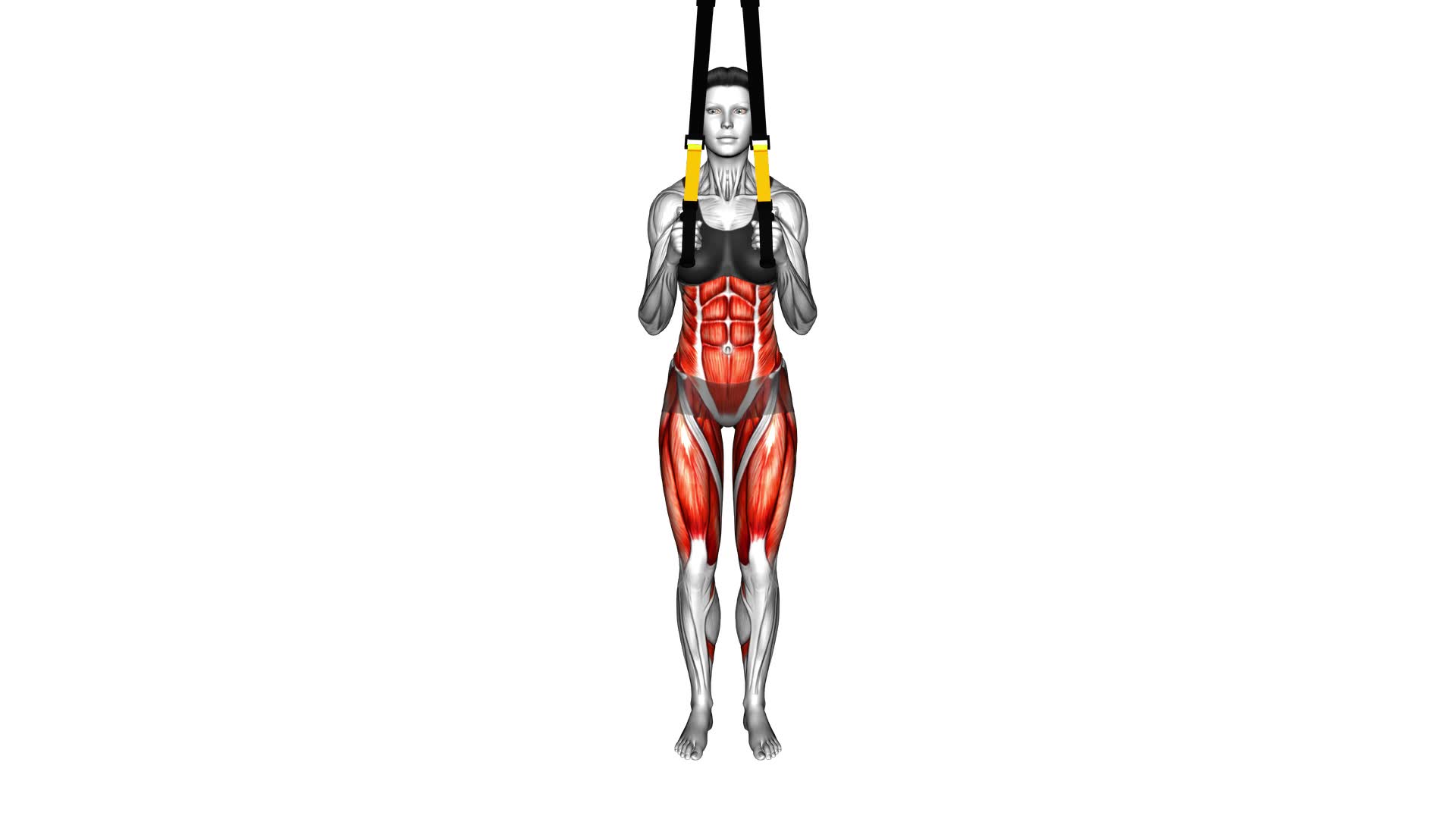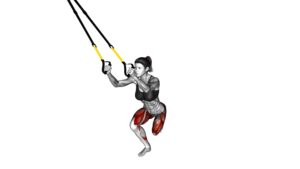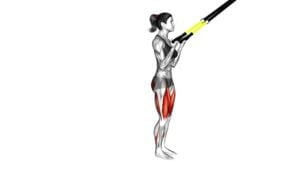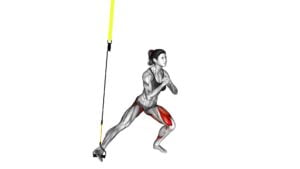Suspender Side Lunge (female) – Video Exercise Guide & Tips

Get ready to tone your legs and strengthen your core with the Suspender Side Lunge. In this video exercise guide, we'll show you the proper form and technique, as well as common mistakes to avoid.
Watch This Exercise Video
Whether you're a beginner or advanced fitness enthusiast, we've got modifications for everyone. Plus, we'll give you tips on how to incorporate this exercise into your workout routine for maximum results.
Let's get started and achieve your fitness goals together!
Key Takeaways
- The Suspender Side Lunge targets glutes, quads, and hamstrings.
- Proper form and technique, such as maintaining alignment and engaging the core, are crucial for muscle targeting and injury prevention.
- Maximizing muscle engagement can be achieved by focusing on maintaining a straight back, pushing hips back, and driving through the heel.
- The exercise can be modified for different fitness levels, with beginner-friendly modifications and advanced level variations available.
Benefits of the Suspender Side Lunge
Improve your lower body strength and flexibility with the Suspender Side Lunge, and experience its numerous benefits.
The side lunge is a versatile exercise that targets the muscles in your glutes, quads, and hamstrings. By incorporating different variations of the side lunge, such as the suspender side lunge, you can add variety to your workout routine and challenge your muscles in new ways.
The suspender side lunge involves attaching suspenders to a resistance band or cable machine and performing the side lunge movement. This adds resistance to the exercise, making it more challenging and effective for building strength. The resistance provided by the suspenders also helps improve stability and balance, as you need to control the movement while resisting the pull of the band or cable.
Incorporating the suspender side lunge into a circuit workout is a great way to maximize your time and get a full body workout. By combining it with other exercises like squats, lunges, and push-ups, you can create a dynamic and efficient workout that targets multiple muscle groups. The suspender side lunge adds an extra challenge to the circuit, helping you build lower body strength and improve overall fitness.
Proper Form and Technique
To perform the Suspender Side Lunge with proper form and technique, it's crucial to focus on alignment. Keep your chest lifted, shoulders back, and core engaged throughout the movement to maintain stability and prevent injury.
Avoid common mistakes such as allowing your knees to collapse inward or rounding your back.
Importance of Alignment
Maintain proper form and technique by aligning your body correctly during the Suspender Side Lunge exercise. Proper alignment is crucial to ensure you receive the maximum benefit from this exercise while minimizing the risk of injury.
Here are some tips for correct form and alignment:
- Keep your feet hip-width apart and parallel to each other.
- Engage your core muscles to stabilize your spine and maintain a neutral posture.
- Step to the side with one leg, keeping your knee aligned with your toes and tracking over your ankle.
- Lower your body by bending the knee of the leg you stepped out with, while keeping the other leg straight.
- Push through your heel to return to the starting position.
By following these alignment tips, you'll target the correct muscles and avoid unnecessary strain on your joints.
Now, let's move on to the next section about avoiding common mistakes.
Avoiding Common Mistakes
To ensure proper form and technique during the Suspender Side Lunge exercise, it's important to be aware of common mistakes and how to avoid them.
One common misconception is that you should lean forward excessively during the lunge. However, this can put strain on your lower back and compromise your form. Instead, focus on keeping your torso upright and engaging your core muscles to maintain stability.
Another challenge isn't stepping far enough to the side, which can limit the effectiveness of the exercise. Make sure to take a wide step, keeping your knee aligned with your ankle, and lower your body into a deep lunge.
Maximizing Muscle Engagement
To maximize muscle engagement during the Suspender Side Lunge exercise, focus on maintaining proper form and technique. Here are some tips to help you get the most out of this exercise:
- Keep your back straight and core engaged throughout the movement. This will ensure proper muscle activation and prevent any strain on your lower back.
- As you step to the side, make sure to push your hips back and bend your knees. This will help engage your glutes and quads more effectively.
- Drive through your heel as you push yourself back up to the starting position. This will further activate your glutes and increase the intensity of the exercise.
- To challenge yourself even more, you can hold weights or resistance bands while performing the Suspender Side Lunge. This will add an extra level of resistance and help strengthen your glutes even further.
Common Mistakes to Avoid
Avoid the common mistakes that can hinder your progress while performing the Suspender Side Lunge exercise. To ensure you get the most out of this workout, it's important to pay attention to proper breathing techniques and be aware of common misconceptions.
One common mistake to avoid is holding your breath during the exercise. Proper breathing is crucial for maintaining stability and providing oxygen to your muscles. Inhale as you lower your body into the lunge position, and exhale as you push back up to the starting position. This helps to engage your core and maintain control throughout the movement.
Another misconception is that the wider the lunge, the better the workout. However, taking too wide of a step can put excessive strain on your knees and lead to injury. Instead, focus on maintaining a moderate stance width that allows for proper alignment of your knees and hips.
Additionally, avoid leaning too far forward or backward during the exercise. This can cause your form to suffer and put unnecessary pressure on your joints. Keep your torso upright and engage your core to maintain stability throughout the movement.
Modifications for Different Fitness Levels
Now let's talk about modifications for different fitness levels. Whether you're a beginner or more advanced, there are options to tailor the Suspender Side Lunge to your abilities.
Beginners can start with modifications that provide extra support and stability, while advanced individuals can challenge themselves with variations that increase the intensity of the exercise.
Let's explore these modifications and variations to help you find the right level for your fitness journey.
Beginner-Friendly Modifications
Try these modifications to make the Suspender Side Lunge exercise more beginner-friendly and suitable for different fitness levels.
Beginner Modifications:
- Perform the exercise without using suspenders or any additional resistance.
- Start with a shorter range of motion, keeping the lunges shallow to reduce strain on the legs.
- Use a chair or wall for balance and stability.
- Increase the rest time between sets to allow for recovery.
Alternative Exercises:
- Stationary lunges: Instead of stepping to the side, keep one foot forward and the other foot back, then lunge down.
- Squats: Stand with feet hip-width apart and squat down, keeping your knees in line with your toes.
- Step-ups: Use a step or platform to step up and down, alternating legs.
Remember to listen to your body and adjust the intensity of the exercise accordingly. These modifications and alternative exercises will help you build strength and improve your fitness level gradually.
Advanced Level Variations
Looking to challenge yourself even further? How can you modify the Suspender Side Lunge to accommodate different fitness levels?
For advanced modifications of the Suspender Side Lunge, there are several techniques you can employ to increase the intensity and muscle activation.
One option is to add resistance to the exercise by using heavier suspension bands or weights. This will require more strength and stability in your legs and core.
Another advanced modification is to incorporate dynamic movements, such as jump lunges or lateral hops, into the side lunge. These explosive movements will engage your muscles even more and enhance your cardiovascular endurance.
Additionally, you can increase the range of motion by performing a deeper side lunge or adding a pulse at the bottom of the movement. These advanced variations will challenge your body and take your fitness to the next level.
How to Incorporate the Suspender Side Lunge Into Your Workout Routine
To incorporate the Suspender Side Lunge into your workout routine, start by adding it as a dynamic lower body exercise. This exercise targets your glutes, quadriceps, hamstrings, and calves, making it an effective way to strengthen and tone your lower body.
Here are some ways you can incorporate the Suspender Side Lunge into your routine:
- Incorporating lunges with other exercises:
- Superset: Pair the Suspender Side Lunge with another lower body exercise, such as squats or deadlifts, to create a challenging superset. This will help maximize your leg strength and endurance.
- Circuit training: Include the Suspender Side Lunge in a circuit workout that combines different exercises targeting various muscle groups. This will add variety and intensity to your routine.
Alternative lunge variations:
- Walking lunges: Instead of performing stationary lunges, try incorporating walking lunges into your routine. This variation adds a dynamic element to your workout and helps improve your balance and coordination.
- Reverse lunges: Switch up your routine by performing reverse lunges. This variation places more emphasis on your hamstrings and glutes, providing a different challenge to your lower body.
Tips for Maximizing Results and Avoiding Injury
To maximize your results and prevent injury while performing the Suspender Side Lunge, focus on proper form and engage your core throughout the exercise. By maintaining proper form, you can target the muscles more effectively and reduce the risk of strain or injury.
Start by standing with your feet hip-width apart and your hands on your hips. Step your right foot out to the side, keeping your toes pointed forward. Bend your right knee and lower your body down into a lunge position, making sure your knee stays aligned with your ankle. Push through your right heel to return to the starting position. Repeat on the other side.
To engage your core, imagine pulling your belly button in towards your spine throughout the movement. This will help stabilize your body and protect your lower back. Remember to breathe deeply and maintain control throughout the exercise.
Frequently Asked Questions
How Many Calories Does the Suspender Side Lunge Exercise Burn?
The suspender side lunge exercise is a great way to work your lower body muscles and burn calories. When performed with proper form and technique, it can be an effective calorie-burning exercise.
However, the exact number of calories burned during this exercise can vary depending on factors such as your weight, intensity, and duration. To maximize calorie burn, focus on maintaining proper form and engaging your muscles throughout the movement.
Can the Suspender Side Lunge Help Improve Flexibility?
The suspender side lunge can be a great exercise for improving hip flexibility. By incorporating this exercise into your routine, you can target the muscles in your hips and thighs, helping to increase their range of motion.
This can be beneficial for activities that require hip mobility, such as sports or dancing. Additionally, the suspender side lunge can also help strengthen your lower body and improve overall balance.
Will the Suspender Side Lunge Help Tone and Strengthen the Inner Thighs?
The suspender side lunge is an effective exercise for toning and strengthening your inner thighs. By incorporating inner thigh exercises like this into your routine, you can target and engage the muscles in that area, resulting in improved tone and strength.
Side lunges, in general, offer a variety of benefits, including increased flexibility, improved balance, and enhanced lower body strength. So, adding the suspender side lunge to your workout can help you achieve your fitness goals.
Is It Safe to Perform the Suspender Side Lunge if I Have Knee or Hip Pain?
If you have knee or hip pain, it may not be safe to perform the suspender side lunge. It's important to listen to your body and avoid any exercises that exacerbate your pain.
Instead, you can try modifications like reducing the range of motion or using a support, such as a chair or wall, for balance.
Additionally, there are alternative exercises that can help strengthen your inner thighs without putting stress on your knees or hips.
Can the Suspender Side Lunge Be Done Without Using Suspenders or Any Equipment?
Yes, you can definitely do the suspender side lunge without using suspenders or any equipment.
Alternative modifications include performing the exercise with just your bodyweight or using a resistance band for added resistance.
However, it's important to note that using suspenders or equipment can provide additional benefits such as better stability and control during the movement.
Conclusion
Incorporating the suspender side lunge into your workout routine can provide numerous benefits. This exercise is effective for strengthening your leg muscles and improving balance and coordination. It targets the quads, glutes, and hamstrings, making it a great addition to any lower body workout.
To perform the suspender side lunge correctly, start by standing with your feet shoulder-width apart. Take a step to the side with one foot, keeping your toes pointing forward. Bend your knee and lower your body as you push your hips back. Your other leg should remain straight. Push through your heel to return to the starting position.
One common mistake to avoid is letting your knee collapse inward during the lunge. This can put stress on the knee joint and increase the risk of injury. Make sure to keep your knee in line with your toes throughout the movement.
If you're new to this exercise or have any physical limitations or injuries, it's important to make modifications based on your fitness level. You can use a suspension trainer or hold onto a sturdy object for support and stability.
Remember to consult with a fitness professional if needed and always listen to your body. If you feel any pain or discomfort during the exercise, stop immediately. It's better to start with lighter weights or regress the movement rather than risk injury.
So, incorporate the suspender side lunge into your routine and enjoy the benefits it brings. Happy lunging!

Author
Years ago, the spark of my life’s passion ignited in my mind the moment I stepped into the local gym for the first time. The inaugural bead of perspiration, the initial endeavor, the very first surge of endorphins, and a sense of pride that washed over me post-workout marked the beginning of my deep-seated interest in strength sports, fitness, and sports nutrition. This very curiosity blossomed rapidly into a profound fascination, propelling me to earn a Master’s degree in Physical Education from the Academy of Physical Education in Krakow, followed by a Sports Manager diploma from the Jagiellonian University. My journey of growth led me to gain more specialized qualifications, such as being a certified personal trainer with a focus on sports dietetics, a lifeguard, and an instructor for wellness and corrective gymnastics. Theoretical knowledge paired seamlessly with practical experience, reinforcing my belief that the transformation of individuals under my guidance was also a reflection of my personal growth. This belief holds true even today. Each day, I strive to push the boundaries and explore new realms. These realms gently elevate me to greater heights. The unique combination of passion for my field and the continuous quest for growth fuels my drive to break new ground.



